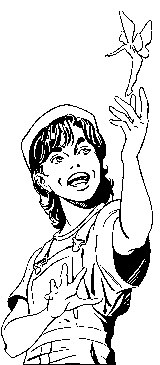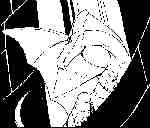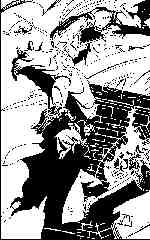"Chance Encounters"
by Roger A. Ash
June, 1996
 Leave it to Chance by
writer James Robinson (Starman) and artist Paul
Smith (X-Men) debuts this month from Homage Comics.
This is the first project the two have done together since DC's
The Golden Age. "We never really sat down and
decided to do a story together as much as we decided that we were
both interested in doing something that we felt wasn't being done
in comics," says Paul Smith on the genesis of Leave
it to Chance. "Which was something that wasn't gender
specific, that wasn't so darn grim and gritty and dark and mean
and misogynistic. Where was the fun? Where were the characters
that one can respect? Someone you could take home to meet your
mother? It was our mutual interest in creating something along
those lines that made me think that, once he gave me his idea,
this is a great story."
Leave it to Chance by
writer James Robinson (Starman) and artist Paul
Smith (X-Men) debuts this month from Homage Comics.
This is the first project the two have done together since DC's
The Golden Age. "We never really sat down and
decided to do a story together as much as we decided that we were
both interested in doing something that we felt wasn't being done
in comics," says Paul Smith on the genesis of Leave
it to Chance. "Which was something that wasn't gender
specific, that wasn't so darn grim and gritty and dark and mean
and misogynistic. Where was the fun? Where were the characters
that one can respect? Someone you could take home to meet your
mother? It was our mutual interest in creating something along
those lines that made me think that, once he gave me his idea,
this is a great story."
What is the concept behind Leave
it to Chance? Writer James Robinson explains: "The
book is set in a city called Devil's Echo where anything and everything
supernatural and other-worldly that can happen does. It's been
this way since the town was founded, so the town has had an occult
protector since the time of the pilgrim fathers. This has always
been a Falconer, that's the name of the family, and the role of
occult protector of Devil's Echo has been handed down from father
to child, and that's how it has been, and that's how it always
will be. So we cut to the present to 14-year-old Chance Falconer.
She's a young girl full of eagerness to take over the Falconer
mantle when she's old enough. When it's time for her training
to begin, she goes to her father and he says that because she's
a girl, she will be denied the privilege. Instead, he says, when
you grow older, you'll have a son, I'll train him, the Falconer
tradition will skip a generation, no harm done. Chance is determined
to prove her father wrong, that she's capable of the job, and
so she goes out to get involved in whatever mysteries need solving,
whatever supernatural menaces need vanquishing. She's aided in
this by a dragon familiar, called St. George, who is her Watson
meets Ace the Bat-Hound. He's a little dragon, sort of like a
terrier that breathes fire. This book has lots of thrills, lots
of excitement, and hopefully it will appeal to both sexes and
all ages. We're also trying to do a book that's light and fun
and in some ways is reminiscent of really good 60s Marvel comics."
"The first four issues center
around a Shaman, an Indian mystic, who's been brought to town,"
says Robinson. "He's attacked in a supernatural battle and
is in a coma. His young daughter is a hostage between two rival
political groups who are trying to win the mayoral race of Devil's
Echo. At the same time, there are sewer goblins that are an ongoing
threat and there's one person who's pulling the strings behind
everything, which will ultimately lead to a monstrous menace that
will rise up and threaten to destroy the entire city. And we'll
introduce Chance, her father and the other supporting characters.
After that, we'll be doing a couple of smaller stories which show
the city. Because the city has always had a supernatural root
to it, their equivalent of Mardi Gras is Halloween when they have
a huge carnival that goes through the city. Chance'll be involved
in an adventure that takes place in one night running parallel
with the Mardi Gras, so we'll get to see various aspects of the
city and various ethnic groups that are strong within Devil's
Echo. There's a heavy Egyptian ethnic group in Devil's Echo and
there'll be a story involving Egyptian mythology. After that,
there's a story involving smugglers. Devil's Echo is on the Atlantic
Ocean and this story will involve sea monsters and a lot of the
archetypes that we would expect around a smuggling story, but
it is thrown on its ear by it being in a contemporary setting
with this hip young girl involved."
 This is the first time in quite a while
that Smith has worked on a continuing series. How does he feel
to be doing it again? "This working for a living is a lot
harder than I remembered," laughs Smith. "The hardest
part about it actually is the desire to get everything just right.
When you take over somebody else's strip, everything is pretty
much set - Aunt May looks like Aunt May. But I'm starting from
scratch here, so that's driving me a little nuts. Every once in
a while, you just get to a point where you have to say, that's
close enough, because you're on a regular schedule and you have
to get the book done."
This is the first time in quite a while
that Smith has worked on a continuing series. How does he feel
to be doing it again? "This working for a living is a lot
harder than I remembered," laughs Smith. "The hardest
part about it actually is the desire to get everything just right.
When you take over somebody else's strip, everything is pretty
much set - Aunt May looks like Aunt May. But I'm starting from
scratch here, so that's driving me a little nuts. Every once in
a while, you just get to a point where you have to say, that's
close enough, because you're on a regular schedule and you have
to get the book done."
How do Robinson and Smith work together
on an issue? "James supplies me with what he envisions happening
in particular scenes and dialog," says Smith. "Then
I'll do 2" x 3" thumbnails that may be very close to,
or may vary widely from, what he had written originally. I send
these thumbnails to him and he responds to them by tightening
up dialog or changing dialog, it just keeps going back and forth
like this. It's a constantly evolving process until it finally
gets done."
One of the things that appealed to
Robinson about Leave it to Chance was the opportunity
to do something different. "I am trying to do something atypical
to what's expected of me," he says. "I know I get a
reputation for doing stuff that's a little bit left of center,
but firmly entrenched within the mainstream superhero universe.
I guess that began when I did The Golden Age. I
wanted to do something that was lighter and fresher while I continued
with Starman, without the two conflicting too heavily
with each other. I also wanted to do a character that appealed
to both sexes. There's a strong male character in it in Lucas
Falconer, who is only in his 40s, he's a very dynamic figure -
kind of an occult Sherlock Holmes. But at the same time, I wanted
to introduce a female character that boys wouldn't be alienated
by but that girls would also be inclined to pick up and enjoy
the adventures of. Also, the premise is so easy to comprehend,
new readers can hop onto the book every few issues. You don't
have to have read fifty issues of it to understand it, which is
how it's getting with Starman. Starman
is a book where there's lots of characters and lots of backstory,
and that's fine. Some books that suits. It suited Sandman,
it suits Starman, the X-Men, people
dig that. But at the same time, it's nice to have a book where
you don't need to understand a lot of stuff, like Batman.
You just need to know that his parents were killed and he goes
out to fight crime to avenge their deaths. That's the very simple
kind of premise we'd like to set up."
The city of Devil's Echo seems almost
like another character in Leave it to Chance, the
same way that Opal City does in Starman. Why does
Robinson feel that the cities are so important to the stories?
"Certain authors in fiction have used cities like characters.
The immediate one that comes to mind is Conan Doyle with Sherlock
Holmes. Dashiel Hammet, if you think about it, used San Francisco
to great effect in a lot of his work, Chandler as well with Los
Angeles. I don't know that it makes it better fiction, but it's
certainly fiction I enjoy reading myself. I think a good Batman
story involves Gotham City, I always have done." Since the
city is important, did Smith put a lot of time designing it? "I
spent a lot of time thinking about it. Most of the things I've
actually done have been thrown out. Architecture has never been
my strong suit. It's starting to come together."
When asked how this differs from his
previous work, Smith replies, "Well, it's mine. That's a
biggie. It will hopefully be able to cross over into other audiences
better than anything else I've ever done. My analogy has been
like Rocky & Bullwinkle: you watch it when you're
five and it's funny. You watch it when you're 25 - it's still
funny, maybe in a different way. You watch it again when you're
50, it's still funny. It doesn't matter how old you are,
you can always enjoy that. Which is not to say that Chance
is a comedy, but that we hope it will be non-gender and non-age
specific in terms of its fan base."
 Apart from Leave it to Chance,
Robinson continues his work on DC's Starman, and
gives us this look ahead at what happens after the conclusion
of the Sandman Mystery Theatre crossover. "We
go into an arc called To Hell and Back, which is the poster
demon trilogy and it sows the seeds of the growing friendship
between the Shade and Matt O'Dare, who is the corrupt reincarnation
of Scalphunter. This involves Jack, Shade and Matt O'Dare going
to hell and wrestling with their own personal demons while bargaining
with a real demon in the netherworld. There's a Times Past
story called Backstabbers and Superfreaks, and it features
the blue alien Starman. The whole story takes place in a discotheque
over one night. The art is by Craig Hamilton and it's some of
the most beautiful artwork you're going to see in a comic book
this year. We're going to have a Christmas issue, which is something
I've always wanted to do in a comic book. Then we go into an arc
which involves the Black Pirate, the old Golden Age character.
This is juxtaposed with a mad bomber character called the Infernal
Doctor Pip, who has a vendetta against the city that will slowly
be uncovered by Jack. The two stories run in tandem, and when
the Dr. Pip story is over, redeeming the ghost of the Black Pirate
becomes a major storyline. This will, hopefully, flow into a crossover
with Captain Marvel. That is tentatively the plan. I've sort of
roughly got it mapped out right through to the end, and there's
a lot to come, but I don't want to get too far ahead. Hopefully
within the next twelve issues, Jack will go off into space to
find Will Payton." So there will be an end to Starman?
"The thing that happens when you do these monthly books is,
whether you like it or not, the way that the series should end
pops into your head and then you can't really shake that. You
just end up having to work towards that," explains Robinson.
"When the time comes to end the book, I know how I'd like
to do so, but I have no intention of ending the book any time
soon."
Apart from Leave it to Chance,
Robinson continues his work on DC's Starman, and
gives us this look ahead at what happens after the conclusion
of the Sandman Mystery Theatre crossover. "We
go into an arc called To Hell and Back, which is the poster
demon trilogy and it sows the seeds of the growing friendship
between the Shade and Matt O'Dare, who is the corrupt reincarnation
of Scalphunter. This involves Jack, Shade and Matt O'Dare going
to hell and wrestling with their own personal demons while bargaining
with a real demon in the netherworld. There's a Times Past
story called Backstabbers and Superfreaks, and it features
the blue alien Starman. The whole story takes place in a discotheque
over one night. The art is by Craig Hamilton and it's some of
the most beautiful artwork you're going to see in a comic book
this year. We're going to have a Christmas issue, which is something
I've always wanted to do in a comic book. Then we go into an arc
which involves the Black Pirate, the old Golden Age character.
This is juxtaposed with a mad bomber character called the Infernal
Doctor Pip, who has a vendetta against the city that will slowly
be uncovered by Jack. The two stories run in tandem, and when
the Dr. Pip story is over, redeeming the ghost of the Black Pirate
becomes a major storyline. This will, hopefully, flow into a crossover
with Captain Marvel. That is tentatively the plan. I've sort of
roughly got it mapped out right through to the end, and there's
a lot to come, but I don't want to get too far ahead. Hopefully
within the next twelve issues, Jack will go off into space to
find Will Payton." So there will be an end to Starman?
"The thing that happens when you do these monthly books is,
whether you like it or not, the way that the series should end
pops into your head and then you can't really shake that. You
just end up having to work towards that," explains Robinson.
"When the time comes to end the book, I know how I'd like
to do so, but I have no intention of ending the book any time
soon."
Also on the way are more single-issue
Times Past stories in Starman. Does Robinson
know in advance who he's going to work with on these stories and
tailor the stories to the artist? "I always know in advance
with the Times Past, and I do tailor," he says. "For
instance, upcoming is a western Scalphunter story with art by
Tim Bradstreet; there'll be one by Bret Blevins that is a sort
of Victorian mystery story; there's a Will Payton adventure with
art by Richard Pace; and hopefully there'll be one with the Demon
by Duncan Rouleau, which is set in the 1940s and features Ted
Knight. So they all have a different feel, hopefully working towards
the strength of that artist. Also upcoming is the Starman
Annual for this year. The framing sequences for all the
annuals this year are in the far future and earth has died, and
these are all myths that may or may not be true. I felt I had
so much story to tell already, I didn't want to labor it down
with stories that might not be true, so I chose to tell two stories
that were true and they're told by the Shade. One of them is the
first meeting of Ted Knight and Billy O'Dare, who is the father
of the current crop of O'Dare's and it's a 1940s horror/crime
story with amazingly beautiful art by J.H. Williams. The other
story is the death of the Steve Ditko Prince Gavin Starman. He
died in Crisis in one panel, a very oblique death,
so I'm showing his death from his point of view and this will
tie in with the Will Payton storyline to come. Art for that is
by Bret Blevins and the bridging sequences are by Craig Hamilton."
But there is more than Leave
it to Chance and Starman in Robinson's future.
"I'm working on a three-issue arc of Legends of the
Dark Knight with art by Paul Johnson and I've just talked
with Kevin Nowlan about doing a single issue Legends of
the Dark Knight. Apart from that, the ball is slowly rolling,
finally, on The Silver Age. Hopefully some news
that we're doing that will be forthcoming eventually. I've also
written the four issues for the Shade mini-series
and that is a story that goes through the ages from 1727 to the
present with four different artists. The first issue is by Gene
Ha, the second by J.H. Williams, the third by Bret Blevins, and
the fourth by Michael Zulli."
|
|